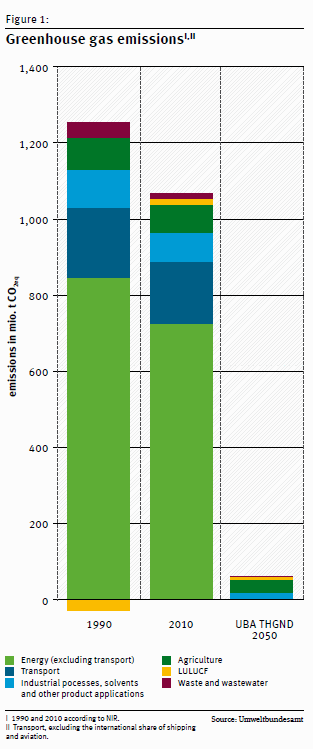Germany’s Environmental Agency (Umweltbundesamt or UBA) has come up with a proposal for a 95 percent reduction of greenhouse gas emissions by 2050, far more than the country’s current goal of an 80 percent reduction. Craig Morris points out that the recommendations are intended not only for a German audience.

Agriculture might be the single biggest source of CO2 emissions by 2050. (Photo by southgeist, CC BY-SA 2.0)
The UBA has published a 32-page study in English investigating how Germany can go from around 10 tons of CO2-equivalent emissions per capita and year today to less than one ton by 2050. And it wouldn’t be Germany if the proposal did not specify that “we do not need nuclear power or underground CO2 sequestration” [carbon capture and storage, CCS].

Germany has reduced its carbon emissions substantially over the past two decades about but can it become nearly carbon-neutral by midcentury? (Source: UBA)
Since Germany has little further hydropower and geothermal potential, we are left with biomass, wind, and solar. And the UBA says it “sees no future in cultivated biomass,” meaning dedicated energy crops. Instead, the focus will be on energy from waste. And since the word “lignocellulosic” does not occur in the study (nor does “woody biomass,” the layman term), we can assume that the UBA also sees no options for what is now being sold as “advanced biomass.”
The UBA thus believes Germany will have to make it with wind and solar primarily – a sobering conclusion when we consider the amount of power that will need to be stored in the process. But the UBA turns this challenge into an opportunity when it calls for excess renewable power to be stored as fuel to power the remaining non-electric vehicles along with planes, ships, and trucks.
Industry is often overlooked when the potential of renewables is discussed, but the UBA believes that the sector’s primary type of demand – space heating and process heat – can also largely come from renewable electricity and synthetic gas from excess renewable power. That still leaves out the petroleum-based feedstock materials consumed by industry, which would also need to be substituted with “hydrocarbons generated from renewable energy.”
Here, we see that the study takes a larger approach than just energy – and finds that “the largest emitter in 2050 might turn out to be agriculture.” In fact, the 2050 scenario has agriculture making up more than half of the emissions pie at 35 million tons of carbon equivalent out of a total of 60. This sector can only reduce its emissions even further if less cattle – a major source of methane – are raised, which would mean not only a further reduction in red meat consumption, but also dairy products.
Though no chapter is devoted to it, efficiency is a theme throughout the study. Overall, the UBA sees final energy consumption falling from just over 2,600 TWh to around 1,300 TWh by 2050 – without a reduction in economic growth or standards of living.
Still, a reduction from 10 to just under one ton per capita per year would mark a more than 90 percent reduction, not 100 percent. To go the full distance, the UBA says that “the last remaining tonne per capita could be offset by reduction measures outside Germany.” But of course, it is also possible to export emissions, such as when cattle farming is reduced but meat consumption remains unchanged, thereby increasing meat imports. In that case, Germany might be 95 percent carbon-free domestically but have a greater impact overall.
In the end, the study is not really about what Germany can do, however, but about what “large industrialized countries” can. Germany is often ridiculed for its poor solar and wind conditions. Does that mean that if Germany can do it, it will be so much easier for so many other countries?
Craig Morris (@PPchef) is the lead author of German Energy Transition. He directs Petite Planète and writes every workday for Renewables International.